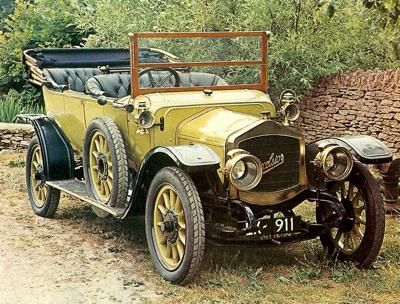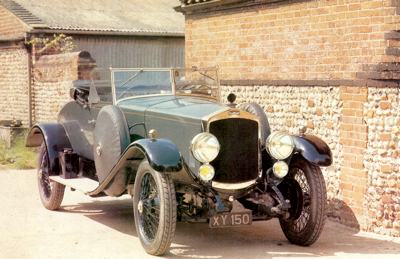|
Excelsior
|
1901
- 1932 |
Country: |
 |
|
Belgium may have been rich in natural resources and skilled labour, but it had a total population of only six million - which was well short of the number required to support an indigenous motor industry. Yet, at peak production just before World War 1, Belgium could boast some fifteen to twenty car makers employing over 5000 workers.
Some were voiturette makers serving only the home market - which was so insignificant that Ford, who was already selling in most European countries, did not find it worthwhile to open a Belgian assembly plant until 1922. The best-known, though, were luxury cars built very definitely for export. Of these luxury cars, perhaps the finest was the Excelsior.
Arthur de Coninck
The Excelsior company had been founded in Brussels in 1901; the initial products were unremarkable light cars fitted with proprietary engines - in 1905 one, two and four-cylinder Aster power units were available. In 1907, however, Arthur de Coninck, an engineer, took over the factory and, before long, Excelsior was producing his Type Adex, a side-valve six-cylinder model. Around this time, too, Excelsior acquired the factory of the moribund Belgica car company.
The 1911 Coupe de l'Auto at Boulogne
Around 1910, the company began to appear in international competition first at an Ostende meeting, then, more seriously, with the entry of a team of light cars in the 1911 Coupe de l'Auto at Boulogne. These 3-liter cars were reputedly capable of 88 mph at 3000 rpm, although none was placed; a few weeks later, one of the cars, driven by Riviere, took part in the chaotic Grand Prix de France - Le Grand Prix des Vieux Tacots (old crocks' GP) - and stripped its timing gears after a couple of laps.
The Coupe de Liederkerke
The marque did better on home ground, however, carrying off the Coupe de Liederkerke. The year 1911 had also seen the introduction of the classic Edwardian Excelsior, the 4.s-liter, 29/30 hp Adex six, with the cylinders cast in two blocks of three and, according to the specification issued by the English importers, H. M. Hobson of Pall Mall, a water-tooled exhaust. There was also a 14/20 hp four, with the same cylinder dimensions (85 mm bore x 130 mm stroke) as the six, but having the cylinders cast en bloc. Both were side-valve units, but sporting overhead-valve versions were also available.
Christaens and L. G. 'Cupid' Hornsted
The range, originally announced with three-speed transmissions, had acquired four forward gears by the end of 1913. In 1912, a solitary 9.1-liter Excelsior, the first six-cylinder car to compete in a Grand Prix (the 1908 GP Napiers never made the starting line) ran in the French Grand Prix at Dieppe, driven by Christaens, and finished in sixth place. In the following year, the company fielded two 6.1-Iitre cars in the French GP at Amiens; the drivers were Christaens and the Englishman L. G. 'Cupid' Hornsted. Plagued by defective sparking plugs, the Excelsiors could manage no better than an eighth place for Christaens.
 1911 Excelsior side-valve 14/20 four.
1911 Excelsior side-valve 14/20 four.
 1925 Excelsior Adex.
1925 Excelsior Adex. |
The Brussels - St Petersburg
However, Christaens did carry off first place in the arduous Brussels St Petersburg race of 1913 with a touring Adex, and then travelled to the US where he came sixth in the 1914 Indianapolis 500 with one of the 1913 GP racers. After the war, Belgium's motor industry was in a crippled state, so it was hardly surprising that De Coninck continued the pre-war Adex six into 1919, but in 1920 came a new overhead-cam Adex with the notable improvement of his own system of diagonally compensated four-wheel brakes.
The Excelsior Albert Premier
This new Adex was developed, in 1922, into the magnificent Albert Premier model, a 5350 cc six with an overhead camshaft operating valves whose diameter was more than half that of the cylinder bore; triple Zenith carburetors were standard. Like the 1920 Adex, the Albert Premier had cantilever rear suspension with Adex anti-roll bars, probably the first use of this feature on a touring car.
In 1926 came a new Albert Premier, the 31/100, with a considerably improved specification. Its seven-bearing crankshaft was balanced both statically and dynamically and pressure lubricated; now only one carburetor was fitted, and on a new type of inlet manifold which incorporated a take-off pipe for the Dewandre brake servo.
The connecting rods were tubular, an oil-cooler radiator was another addition, and the gearbox still with its four forward speeds. The wheelbase was just It in short of 12 feet, and the standard chassis cost £1150 in the UK, the super sports version being £1250. The Albert Premier had a genuine sporting record to back up the title 'super sports': in 1923, the marque had taken sixth and eighth places in the first Le Mans 24-hour race and fifth and seventh places in the Georges Boillot Cup at Boulogne.
The Circuit des Routes Pavees
In 1925, an Excelsior driven by Charlier made the fastest lap in the Circuit des Routes Pavees and took third place; the next year, Caerels's car won this event and came second in the Belgian 24-hour race at Spa. The marque's competition record came to a triumphant end in 1927, with Albert Premiers taking first and second places in the Spa 24-hour event. The shades of night were falling fast for Excelsior by this time. In 1927, it was rumoured that they were about to be acquired by FN; a year later came a take-over in reality, and the company was merged with Imperia of Nessonvaux.
The new Societe Anonyme des Automobiles Imperia Excelsior showed their joint products at Olympia in October 1928; it was noted that the old Albert Premier had been down-graded, and was now known as a 30/80 hp. The last year of serious production seems to have been 1929; Excelsior production had never been large and sales, even in export markets, were low. A few Albert Premiers were assembled from existing parts to meet the occasional order until 1932; it was a lingering death for a car that in its day had ranked with
Hispano-Suiza and
Bentley.
